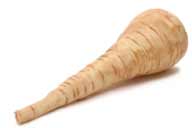I frequently spend a lot of time asking people to eat the colors of the rainbow. There are so many tasty colorful foods that I am at a loss to understand how the Standard American Diet came to be mostly beige. On my Facebook Fan Page I often push colorful foods. For the most part this means fruits and vegetables that are higher in nutrients, tasty and easy to incorporate into the diet in their whole food form.
Today however I'm here to advocate for white foods; at least some of them. I'll still be one of the first to tell you that white rice, white pasta, white bread, white potatoes and that ilk are primarily simple carbs and not a great choice. But there are some other white foods that are fabulous and should definitely be part of your nutritionally dense, healthy eating plan.
| Cauliflower ] photo: Liftarn |
Cauliflower – A cruciferous vegetable that is loaded with vitamin C, cauliflower also provides vitamin K, and some folate. It's also got a type of phytonutrient called glucosinolates which are a good choice for detoxification activity within our bodies. Antioxidant and anti-inflammatory properties make cauliflower high on the list for cancer prevention and heart health while it's high levels of fiber make it a great choice for supporting healthy digestion. You can eat it raw, steamed, baked, roasted, and cooked. Don't forget about the greens, these are also edible and make a great addition to a stir fry or curried greens.
 |
| Parsnip | photo: A.Cahalan |
Parsnips – A root vegetable that is loaded with fiber, parsnips also provide vitamin C, vitamin K and folate. They have a wonderful mineral content that includes calcium (yes folks, 1 C. of parsnips gives you 5% of your RDV for calcium), magnesium, phosphorus, potassium, and manganese. I've read that before people knew that potatoes were edible, parsnips were one of the prized root vegetable for their mild, delicious flavor. They can be eaten raw, cooked, mashed, steamed, and make a wonderful addition to a root vegetable medley or a carrot, sweet potato, parsnip latke.
 |
| Garlic | photo: geocachernemesis |
Garlic – Another wonderful root vegetable garlic is a fabulous antiviral, antibacterial, antifungal, cancer fighting, immune system boosting food that needs to be a part of your diet. If chopped and let to sit for a few minutes oxidization boosts the powerful antioxidant allicins. Many people, myself included, when feeling a little under the weather, will chop a clove or two of garlic and swallow it down raw (do not do this on an empty stomach as it may cause digestive upset). Delicious, healthy, easy to use in a vast array of dishes, it's one white vegetable that belongs in your pantry. As tasty as it is, it's no wonder that there's a recipe for chicken with 40 cloves of garlic.
 |
| White Onion | photo: multadroit |
Onions – there are all different types of onions so it seems a bit odd to single out the white ones since I tend to use them all. The white ones include sweets, cipollinis, shallots, pearl onions and more. Try them all, they're delicious and so good for you. High in chromium, which is great for your blood sugar, onions also have a high level of sulfur compounds which makes them a great choice as a heart healthy, immune boost, cancer fighting, anti-inflammatory vegetable. They also provide copper which is important for bone health.
 |
| Mushrooms | photo: Chris 73 |
Mushrooms – everyone is going crazy for shitake, oyster, portobello, maitake and other mushrooms these days. But that doesn't mean that you should discount those tasty white mushrooms. They pack a nutritious punch with lots of fiber, vitamin B12 (especially important for vegetarians and vegans), potassium, copper, and selenium. 1/2 cup of mushrooms provides a whole lot of flavor yet only 7 calories. Another easy, versatile vegetable they can be used in many different ways in a wide variety of cuisines.
 |
| White Beans | photo: Rasbak |
White Beans – This color covers a number of different kinds of beans, navy, great northern, cannellini, pea beans, and more. A great source of protein, white beans also offer a great source of iron and fiber. They are good for stabilizing blood sugar, good for your heart, your digestion and can be eaten so many different ways. They pair well with an almost endless combination of vegetables, herbs, and spices. One of my favorite ways to eat them is cold (after cooking) in a salad drizzled with a pesto dressing.
 |
| Celeriac | photo: AlbertCahalan |
Celeriac – Sometimes referred to as celery root this tastes like a cross between celery and parsley. It's great in combination with other root vegetables, goes great into a slaw, cooks up well in a casserole, and is another great choice to add to your diet. Low in calories but high in vitamin C, vitamin K, vitamin B6, phosphorus, potassium, and manganese it's considered a detoxifying vegetable. It may also help with blood pressure health and support bone health.
So eat a rainbow of food, whole foods that is, but don't forget white is all the colors of the rainbow and needs to be part of your plate too.

